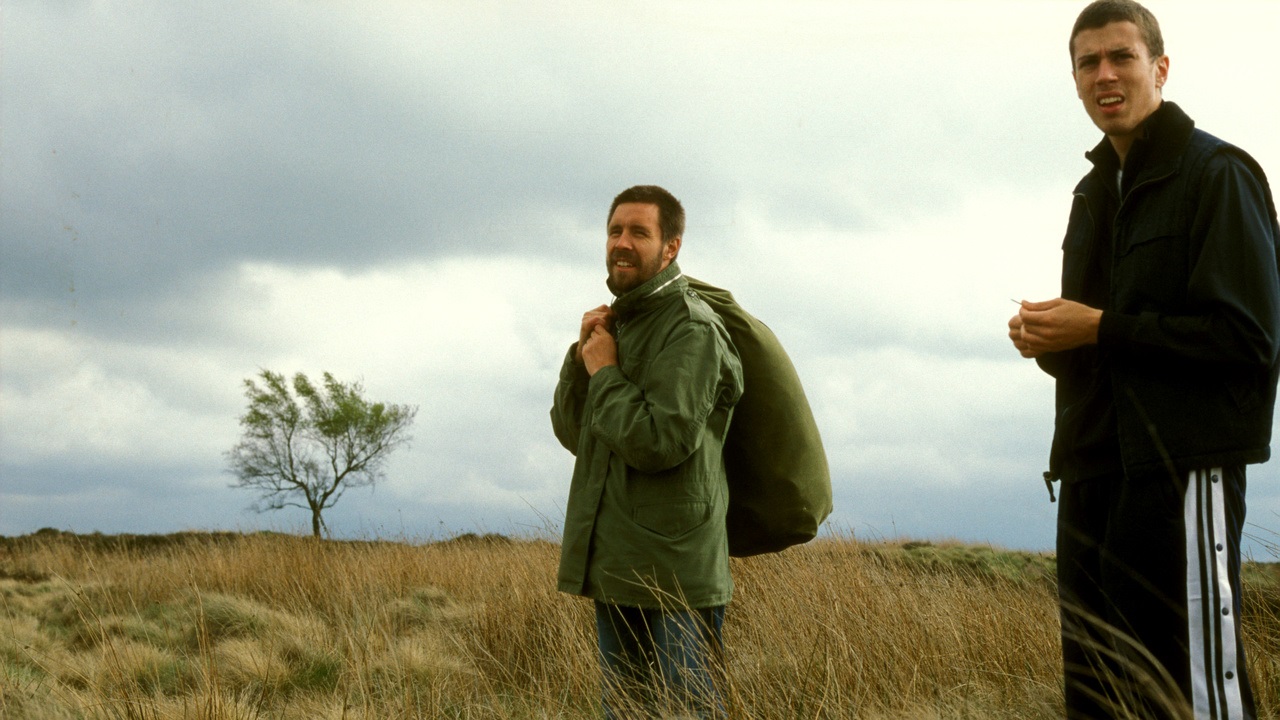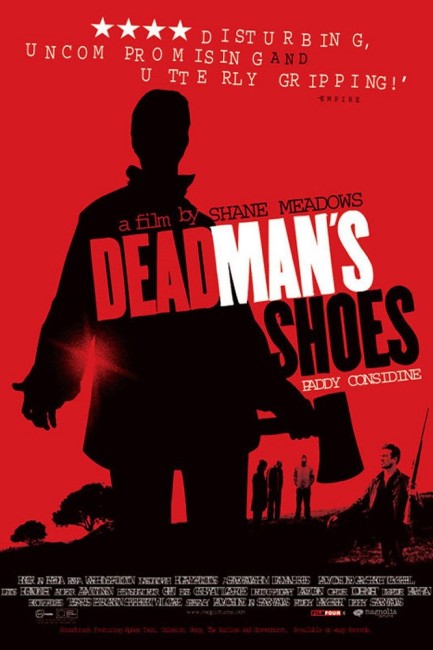UK. 2004.
Crew
Director – Shane Meadows, Screenplay – Paddy Considine & Shane Meadows, Additional Writing – Paul Fraser, Producer – Mark Herbert, Photography (colour + some scenes b&w) – Danny Cohen, Special Effects – Life Creations, Art Direction – Adam Tomlinson. Production Company – Film Four/EMMI/Warp Films/Big Arty Productions.
Cast
Paddy Considine (Richard), Gary Stretch (Sonny), Toby Kebbell (Anthony), Stuart Wolfenden (Herbie), Neil Bell (Soz), Paul Sadol (Tuff), Paul Hurtsfield (Mark), Seamus O’Neal (Big Al), George Newton (Gypsy John), Jo Hartley (Marie), Emily Aston (Patti)
Plot
Richard returns to the sleepy Derbyshire village where he grew up. He immediately starts following a group of local drug dealers and then breaks into their homes and spray-paints them while they sleep. They realize that he is the brother of the intellectually handicapped Anthony who used to hang out with their group. During one of their pranks, they dragged Anthony out to a farm, placed a noose around his neck and left him to hang himself. Richard, who was away in the army, has returned seeking vengeance. Now he ruthlessly stalks and kills each of the men responsible for Anthony’s death.
Dead Man’s Shoes was the fourth film from British filmmaker Shane Meadows. Meadows grew up in rural Staffordshire and started directing his own amateur films, before making his feature debut with Twenty-Four Seven (1997) about a man who creates a boxing club in rural Nottingham. Meadows then went onto the acclaimed likes of A Room for Romeo Brass (1999) and Once Upon a Time in the Midlands (2002) and subsequent to Dead Man’s Shoes, the highly praised This is England (2006) and sequels, Somers Town (2008) and Le Donk & Scor-zay-zee (2009). All of these draw upon the world where Meadows grew up in the English Midlands. He has appropriated a raw, naturalistic style, shooting on digital video and often using non-professionals actors, which gives his films the feel of a handheld camera invisibly looking in on the middle of people’s real lives.
Much of Shane Meadows’ work has been made in conjunction with actor Paddy Considine, a rising actor on British screens. Meadows and Considine once formed a band together, while Considine made his screen debut in Romeo Brass. The two wrote Dead Man’s Shoes together. Meadows apparently drew inspiration from the anger he felt towards the people responsible after learning about a childhood friend who had been bullied to the point that he committed suicide when he returned to Staffordshire after some years.
On one level, Dead Man’s Shoes is not too different to a film like Death Wish (1974) and its numerous imitators about someone seeking violent vengeance for a personal injustice. You could even compare it to a 1980s slasher film in some ways. There is also a degree of similarity to Wilderness (2006), a subsequent British film that also starred Toby Kebbell, about a soldier hunting a group of youths he believed responsible for bullying his son to suicide. (Although, both of these films are at almost completely opposite remove in terms of sympathies – in Dead Man’s Shoes, the sympathy lies with soldier Paddy Considine, while in Wilderness it was with the victims where the hunting soldier them was clearly a crazy). From England, there was also Outlaw (2007) with soldier Sean Bean training a group of people to reclaim justice in their lives, Straightheads/Closure (2007) and Harry Brown (2009) with an aging Michael Caine taking up arms against crime in his neighbourhood.
Dead Man’s Shoes is made in a way that is entirely different to any of these – Shane Meadows shoots the film with a handheld digital camera and uses a cast who have improvised most of their performances. This is, if you like, Death Wish by way of Mike Leigh. Meadows refuses to deliver the film with any typical thriller directorial cues. Many of the scenes that appear – like someone breaking into a house to paint people or leave messages graffitied on walls would seem like standard set-pieces in a slasher film – but are transformed into something very different here.

The various attacks hold a hard punch when they come – and all the more for Shane Meadows letting us watch Paddy Considine slitting someone’s throat or stabbing them as something that is relayed with handheld reality cam rather than a director trying to aim for dramatic emphasis. Particularly good is the climactic scene where Paddy Considine faces final member of the gang Paul Hurtsfield and discovers he is decent and ordinary family man, which brings him to the realization that he himself is the monster, whereupon he gives Hurtsfield his knife and goads him to kill him and stop the bad things he is doing.
Shane Meadows gets a high degree of expressive naturalism from his actors. Paddy Considine gives a performance that takes one aback. His drably dressed, bearded appearance is not what we take the standard avenging hero to be. He plays with a stony implacability that can suddenly explode without notice to jolting effect. The lead villain is played by British boxer Gary Stretch, who had previously played a psycho in Final Combination/Dead Connection (1993). Stretch gives the part a handsome charm that holds a considerable sense of dangerous threat to it. (The only disappointment is that his demise is an unexceptional affair in regard to the build-up he is given).
One newcomer who received some acclaim as a result of the film was Toby Kebbell who subsequently went on to build a modest career for himself in Hollywood. One of the more unusual narrative devices that Shane Meadows employs is having Toby Kebbell accompanying Paddy Considine throughout, with it never being entirely made clear until the end whether he is real or in Paddy’s imagination.
One of the finest aspects of the film is also the beautifully lyrical folk songs on the soundtrack, which are perfectly chosen in terms of placement.
Trailer here


